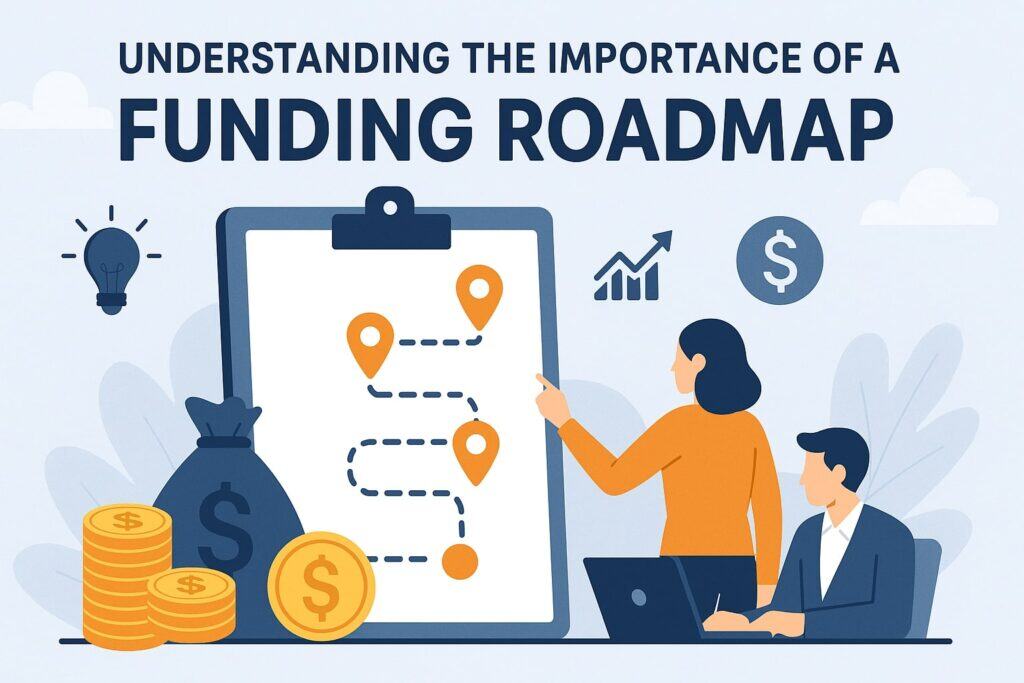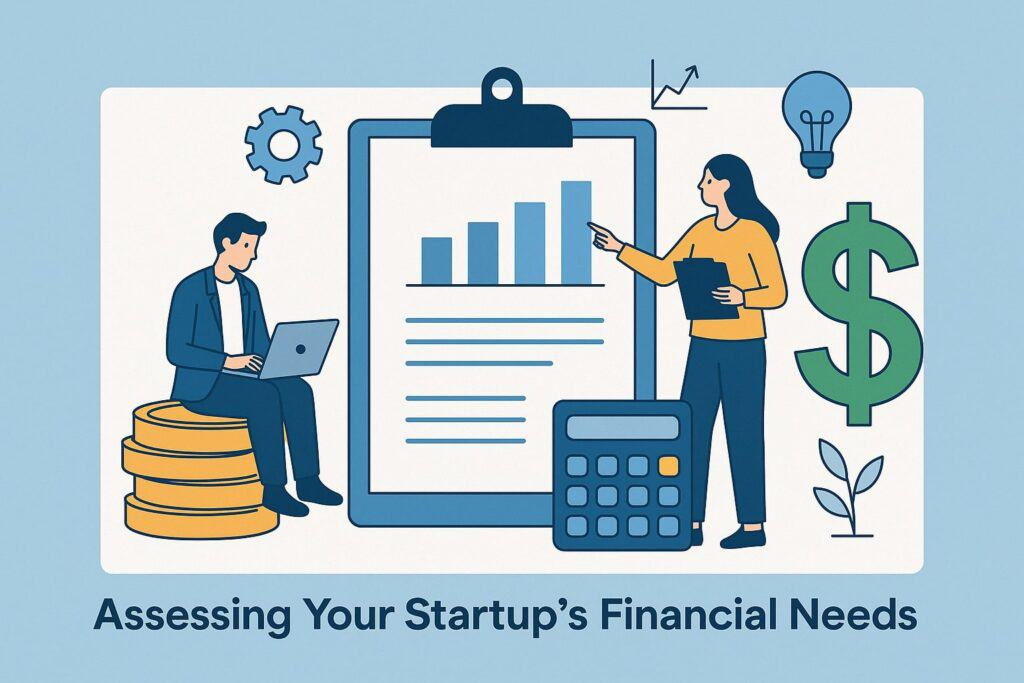
How to Build a Funding Roadmap for Your Startup
Launching a startup is exciting, but it’s also a journey filled with challenges, particularly around financing. While a groundbreaking idea and strong execution are critical, securing funding at the right time is often the lifeline that helps startups survive and scale.
Many entrepreneurs jump into fundraising without a structured approach, only to find themselves facing rejections, diluted ownership, or running out of money before hitting their milestones.
This is where a funding roadmap comes in—a carefully designed plan that outlines how much capital you need, when you need it, and which sources of funding to pursue at each stage.
A funding roadmap is not just about money; it’s about strategy. It helps you align your business milestones with your financing needs, choose the right investors, maintain control over your company, and ensure that every dollar raised serves a clear purpose.
In this comprehensive guide, we will dive deep into the process of building a funding roadmap that is practical, sustainable, and tailored to your startup’s growth journey.
We’ll explore why you need a funding roadmap, how to assess your startup’s financial needs, the different funding sources available, how to plan for seed, Series A, B, and beyond, and practical tips to avoid common mistakes.
By the end of this article, you’ll have a blueprint you can adapt for your own business, ensuring you’re always one step ahead in your fundraising journey.
Understanding the Importance of a Funding Roadmap

Creating a funding roadmap begins with understanding why it matters. Too many founders treat fundraising as a reactionary step—they seek money when they are almost out of cash. This approach often leads to rushed decisions, poor terms, or reliance on the wrong investors.
A funding roadmap, on the other hand, forces you to think proactively. A roadmap provides clarity. It helps you see not only how much capital you’ll need, but also why you need it, and what milestones it will enable you to achieve.
For example, if your startup is building a mobile app, your funding roadmap might show that you need $200,000 to launch a beta version, $1 million to achieve product-market fit, and $5 million to scale into new markets. This clarity makes it easier to pitch investors, as you can articulate a step-by-step journey rather than vague growth ambitions.
It also helps you avoid overfunding or underfunding. Overfunding early can lead to excessive equity dilution, where you give away too much of your company before it’s truly valuable.
Underfunding can leave you struggling to execute on your goals, constantly fundraising instead of building your business. With a roadmap, you balance both sides, raising just enough at each stage.
Beyond money, a funding roadmap improves credibility. Investors prefer founders who demonstrate planning and foresight. When you present a structured roadmap, it signals that you understand not only your product but also the financial mechanics of scaling a company. It reassures investors that their capital will be used strategically.
Finally, a funding roadmap gives you leverage. If you know your milestones and funding needs, you can negotiate from a position of strength, rather than desperation. This often leads to better valuations and more favorable terms.
In short, a funding roadmap is essential because it aligns vision with execution, ensures capital efficiency, strengthens investor relationships, and ultimately increases the odds of long-term startup success.
Assessing Your Startup’s Financial Needs

Before you can build a roadmap, you need to understand your financial requirements. This goes beyond estimating how much money you want—it involves a structured breakdown of your costs, revenue potential, and burn rate.
Start with fixed and variable expenses. Fixed costs include salaries, office rent, and technology infrastructure. Variable costs may include marketing campaigns, customer acquisition, and manufacturing. Being precise in your cost estimates prevents you from underestimating how much you’ll need.
Next, calculate your burn rate—the speed at which you’re spending money relative to your revenue. If your startup burns $50,000 a month, you’ll need at least $600,000 to sustain operations for a year.
However, you must also consider runway—the length of time your startup can survive with its current cash balance. A healthy roadmap ensures you have at least 12–18 months of runway after each funding round.
Revenue projections are another key input. Even if you’re pre-revenue, you need a clear model of how and when revenue will start coming in. This helps determine how much external capital is required to bridge the gap until you’re self-sustaining.
Importantly, align funding with milestones. Don’t raise money for the sake of it—raise enough to achieve specific goals, such as building an MVP, hitting 10,000 users, or generating $1M ARR. These milestones validate your business and make it easier to raise the next round at a higher valuation.
Finally, factor in contingency. Unexpected delays, market shifts, or regulatory challenges can increase your capital needs. Always add a buffer of 15–25% to your funding requirements to ensure you’re not caught off guard.
By thoroughly assessing your financial needs, you create a foundation for your funding roadmap that is grounded in realism, not guesswork.
Exploring Different Funding Options

Once you know how much money you need, the next step is identifying funding sources. Startups today have more options than ever, each with its pros and cons.
Bootstrapping is often the first step, where founders use personal savings or reinvest early revenue. This allows full control but may limit growth if resources are scarce.
Friends and family funding can be a quick way to raise early-stage capital. However, it carries the risk of straining personal relationships if the business struggles.
Angel investors are wealthy individuals who invest in startups in exchange for equity. They’re often more flexible than institutional investors and can provide mentorship alongside funding.
Venture capital (VC) is the most sought-after route for high-growth startups. VCs provide large sums but expect rapid growth and significant equity. They also bring connections and expertise but can exert heavy influence on decision-making.
Grants and government programs offer non-dilutive funding, making them attractive for startups in technology, healthcare, or sustainability. However, competition is fierce, and the application process can be long.
Crowdfunding platforms like Kickstarter or equity crowdfunding portals allow startups to raise funds from a broad audience. This doubles as a marketing tool but requires significant upfront effort to attract backers.
Bank loans and venture debt provide capital without equity dilution, but they require repayment and are risky if cash flow is inconsistent.
The best funding roadmap often combines multiple sources. For example, a startup might bootstrap to MVP, raise angel investment for market entry, and pursue VC funding for scale. The key is to choose sources that align with your startup’s stage, growth potential, and long-term vision.
Designing a Stage-by-Stage Funding Roadmap
A proper roadmap breaks down funding into stages—from ideation to IPO.
- Pre-Seed Stage: Funded primarily through bootstrapping, friends/family, or small angel checks. The focus is on validating your idea and building an MVP. Funding requirements usually range from $50,000 to $500,000.
- Seed Stage: Here, you refine your product, find product-market fit, and start building traction. Funding sources include angels, seed funds, and crowdfunding. Typical rounds range from $500,000 to $2 million.
- Series A: At this point, you need capital to scale operations, hire teams, and expand marketing. Venture capital becomes the main source. Series A rounds often range from $2 million to $15 million.
- Series B and Beyond: These rounds fund aggressive scaling, international expansion, or acquisitions. Funding ranges from $20 million to hundreds of millions, led by large VC firms or private equity.
- Exit/IPO: The roadmap should also include an endgame. Whether through acquisition or public offering, the final step defines how investors will see returns.
Each stage must be tied to clear milestones. For example, you don’t raise a Series A until you can demonstrate significant traction. Designing your roadmap this way ensures you raise the right amount at the right time while maintaining investor confidence.
Common Mistakes to Avoid in Your Funding Roadmap
Even with the best intentions, many founders make avoidable mistakes.
One common mistake is raising too much too early. While it may seem like a big war chest solves all problems, it often leads to excessive dilution and inflated expectations.
Another mistake is failing to plan for the runway. If you raise funds without accounting for at least 12–18 months of operations, you’ll find yourself back in the fundraising cycle too quickly, which distracts from building.
Startups also often ignore alternative funding sources, relying solely on VCs. This narrows flexibility and can cause founders to give up control prematurely.
Lack of transparency is another pitfall. If you fail to communicate clearly with investors about how funds will be used, you risk losing credibility.
Finally, many founders underestimate timeframes. Fundraising can take 6–9 months, and delays are common. A good roadmap factors in these timelines so you’re not left cash-strapped.
Avoiding these mistakes ensures your roadmap is not just theoretical, but a practical tool for success.
FAQs
Q1: How much equity should I give up in early funding rounds?
Answer: The answer depends on your startup’s stage, valuation, and funding needs. In early rounds, founders typically give away 10–20% equity. Giving up too much too soon can leave you with little control later.
However, refusing to dilute at all may prevent you from raising enough to grow. The key is to strike a balance—raise enough to hit meaningful milestones while retaining a majority stake. Remember that valuation is not just about current numbers, but also about potential and negotiation skills.
Q2: When should I start fundraising for the next round?
Answer: The best time to start fundraising is when you still have at least 6–9 months of runway left. Fundraising is a long process involving networking, pitching, due diligence, and negotiations.
Waiting until you’re almost out of money puts you at a disadvantage. A roadmap helps you anticipate when to begin, ensuring you raise before desperation sets in.
Q3: Can I skip certain funding stages if my startup is profitable early?
Answer: Yes. Not all startups follow the same roadmap. If your business model allows you to generate revenue early and reinvest profits, you may not need to raise multiple rounds. Some companies bootstrap to profitability without ever taking VC funding.
However, skipping stages requires strong revenue streams and a market that doesn’t demand rapid scaling to remain competitive.
Q4: How detailed should my financial projections be for investors?
Answer: Investors don’t expect your financial projections to be 100% accurate, but they do expect them to be logical and well-researched. At minimum, you should project revenue, expenses, and cash flow for 3–5 years, tied to realistic assumptions.
Your roadmap should clearly connect funding needs with these projections, showing investors how capital translates into growth.
Conclusion
A funding roadmap is more than a financial plan—it’s a strategic compass for your startup journey. By understanding your financial needs, exploring diverse funding options, and structuring your fundraising by stages, you create a clear path that balances growth with ownership.
Avoiding common mistakes and maintaining transparency with investors ensures your roadmap remains a practical tool rather than a theoretical exercise.